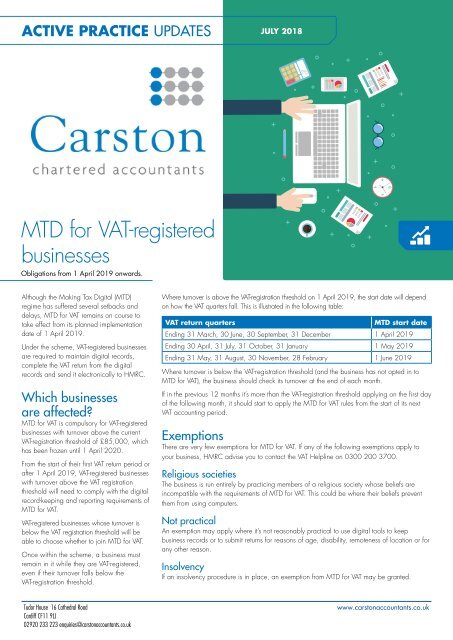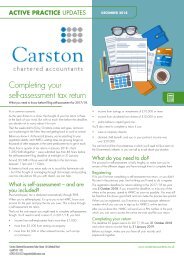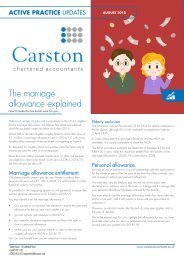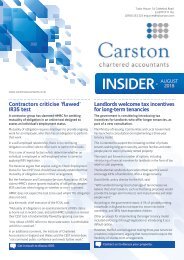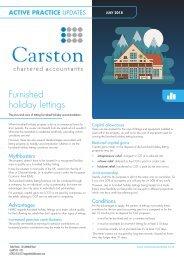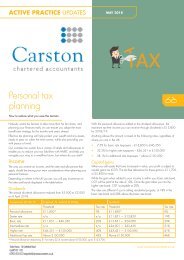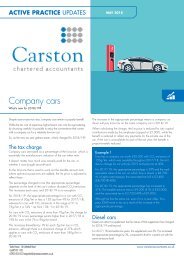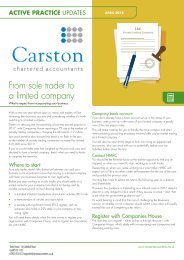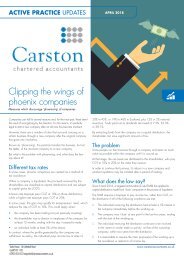MTD for VAT
MTD for VAT Registered Businesses
MTD for VAT Registered Businesses
You also want an ePaper? Increase the reach of your titles
YUMPU automatically turns print PDFs into web optimized ePapers that Google loves.
ACTIVE PRACTICE UPDATES JULY 2018<br />
<strong>MTD</strong> <strong>for</strong> <strong>VAT</strong>-registered<br />
businesses<br />
Obligations from 1 April 2019 onwards.<br />
Although the Making Tax Digital (<strong>MTD</strong>)<br />
regime has suffered several setbacks and<br />
delays, <strong>MTD</strong> <strong>for</strong> <strong>VAT</strong> remains on course to<br />
take effect from its planned implementation<br />
date of 1 April 2019.<br />
Under the scheme, <strong>VAT</strong>-registered businesses<br />
are required to maintain digital records,<br />
complete the <strong>VAT</strong> return from the digital<br />
records and send it electronically to HMRC.<br />
Which businesses<br />
are affected?<br />
<strong>MTD</strong> <strong>for</strong> <strong>VAT</strong> is compulsory <strong>for</strong> <strong>VAT</strong>-registered<br />
businesses with turnover above the current<br />
<strong>VAT</strong>-registration threshold of £85,000, which<br />
has been frozen until 1 April 2020.<br />
From the start of their irst <strong>VAT</strong> return period or<br />
after 1 April 2019, <strong>VAT</strong>-registered businesses<br />
with turnover above the <strong>VAT</strong> registration<br />
threshold will need to comply with the digital<br />
record-keeping and reporting requirements of<br />
<strong>MTD</strong> <strong>for</strong> <strong>VAT</strong>.<br />
<strong>VAT</strong>-registered businesses whose turnover is<br />
below the <strong>VAT</strong> registration threshold will be<br />
able to choose whether to join <strong>MTD</strong> <strong>for</strong> <strong>VAT</strong>.<br />
Once within the scheme, a business must<br />
remain in it while they are <strong>VAT</strong>-registered,<br />
even if their turnover falls below the<br />
<strong>VAT</strong>-registration threshold.<br />
Where turnover is above the <strong>VAT</strong>-registration threshold on 1 April 2019, the start date will depend<br />
on how the <strong>VAT</strong> quarters fall. This is illustrated in the following table:<br />
<strong>VAT</strong> return quarters<br />
<strong>MTD</strong> start date<br />
Ending 31 March, 30 June, 30 September, 31 December 1 April 2019<br />
Ending 30 April, 31 July, 31 October, 31 January 1 May 2019<br />
Ending 31 May, 31 August, 30 November, 28 February 1 June 2019<br />
Where turnover is below the <strong>VAT</strong>-registration threshold (and the business has not opted in to<br />
<strong>MTD</strong> <strong>for</strong> <strong>VAT</strong>), the business should check its turnover at the end of each month.<br />
If in the previous 12 months it’s more than the <strong>VAT</strong>-registration threshold applying on the irst day<br />
of the following month, it should start to apply the <strong>MTD</strong> <strong>for</strong> <strong>VAT</strong> rules from the start of its next<br />
<strong>VAT</strong> accounting period.<br />
Exemptions<br />
There are very few exemptions <strong>for</strong> <strong>MTD</strong> <strong>for</strong> <strong>VAT</strong>. If any of the following exemptions apply to<br />
your business, HMRC advise you to contact the <strong>VAT</strong> Helpline on 0300 200 3700.<br />
Religious societies<br />
The business is run entirely by practicing members of a religious society whose beliefs are<br />
incompatible with the requirements of <strong>MTD</strong> <strong>for</strong> <strong>VAT</strong>. This could be where their beliefs prevent<br />
them from using computers.<br />
Not practical<br />
An exemption may apply where it’s not reasonably practical to use digital tools to keep<br />
business records or to submit returns <strong>for</strong> reasons of age, disability, remoteness of location or <strong>for</strong><br />
any other reason.<br />
Insolvency<br />
If an insolvency procedure is in place, an exemption from <strong>MTD</strong> <strong>for</strong> <strong>VAT</strong> may be granted.<br />
Tudor House 16 Cathedral Road<br />
Cardiff CF11 9LJ<br />
02920 233 223 enquiries@carstonaccountants.co.uk<br />
www.carstonaccountants.co.uk
<strong>MTD</strong> <strong>for</strong> <strong>VAT</strong>-registered businesses<br />
Digital records<br />
Certain records must be kept digitally within functional compatible<br />
software under <strong>MTD</strong>, and be preserved <strong>for</strong> up to six years. These include:<br />
Designatory data<br />
It’s compulsory <strong>for</strong> you to keep a digital record of your business’ name and<br />
an address, which is the principal place of business.<br />
Your business’ <strong>VAT</strong>-registration number and a record of any accounting<br />
schemes used must also be recorded digitally.<br />
Supplies made<br />
For each supply made by your business, you must record the time it was<br />
supplied, how much it was worth at the time and the rate of <strong>VAT</strong> charged.<br />
Multiple supplies made at the same time don’t need to be<br />
recorded separately.<br />
The total value of supplies on each invoice or receipt that have the<br />
same time of supply and rate of <strong>VAT</strong> can be recorded.<br />
A record must also be kept of output values <strong>for</strong> the period split between<br />
standard rate, reduced rate, zero rate, exempt and outside the scope outputs.<br />
Supplies received<br />
For each supply your business receives, you need to record the time of<br />
supply, the value of supply (including any <strong>VAT</strong> that cannot be reclaimed),<br />
and the amount of input tax to be claimed.<br />
If there is more than one supply on an invoice, the totals from the invoice<br />
can be recorded.<br />
The <strong>VAT</strong> account<br />
The <strong>VAT</strong> account provides the link between the digital <strong>VAT</strong> records and the<br />
<strong>VAT</strong> return submitted to the Revenue.<br />
Under <strong>MTD</strong> <strong>for</strong> <strong>VAT</strong>, the in<strong>for</strong>mation which must be held in the <strong>VAT</strong> account<br />
must be maintained digitally and this is referred to as the ‘electronic account’.<br />
To demonstrate a link between the output tax in the business records and the<br />
output tax on the <strong>VAT</strong> return, the electronic account must contain a record of:<br />
• output tax owed on sales<br />
• output tax owed on acquisitions from other EU member states<br />
• any tax to be paid on a supplier’s behalf under a reverse<br />
charge procedure<br />
• any tax owed following a correction or error adjustment<br />
• any other adjustment required by the <strong>VAT</strong> rules.<br />
Similarly, to demonstrate the link between the input tax in the business<br />
records and the input tax on the <strong>VAT</strong> return, the electronic account<br />
must contain a record of:<br />
• input tax which can be claimed on business purchases<br />
• input tax allowable on acquisitions from other EU member states<br />
• tax that can be reclaimed following a correction or error adjustment<br />
• any other necessary adjustment.<br />
Where adjustments are required, only the total value <strong>for</strong> each type of<br />
adjustment will need to be kept digitally.<br />
However, while the underlying calculations don’t have to be made<br />
digitally or using software, and can be per<strong>for</strong>med manually or by using<br />
spreadsheets if preferred, using software should reduce the risk of errors.<br />
The electronic account is vital as the in<strong>for</strong>mation held in it will be used to<br />
calculate and complete the <strong>VAT</strong> return using functional compatible software.<br />
What is ‘functional<br />
compatible software’?<br />
‘Functional compatible software’ is the cornerstone of <strong>MTD</strong> <strong>for</strong> <strong>VAT</strong>.<br />
It will be used to maintain the compulsory digital records, calculate the<br />
return and submit it to HMRC via an application programme interface (API).<br />
Functional compatible software is simply the name given to a software<br />
program, or set of compatible software programs, which are capable of:<br />
• recording and preserving records in an electronic <strong>for</strong>m<br />
• providing in<strong>for</strong>mation and returns from the records to HMRC in<br />
an electronic <strong>for</strong>m using the API plat<strong>for</strong>m<br />
• receiving in<strong>for</strong>mation from HMRC.<br />
It’s possible to mix and match software – the complete set of digital records<br />
needed <strong>for</strong> <strong>MTD</strong> <strong>for</strong> <strong>VAT</strong> don’t need to be held in one piece of software.<br />
As long as there is a link between the different pieces of software, the<br />
records can be held in a range of acceptable digital <strong>for</strong>mats.<br />
The link between the software is key, and is a legal requirement where a set<br />
of compatible software programs is used.<br />
HMRC is likely to produce a list of software from commercial software<br />
suppliers which can be used <strong>for</strong> <strong>MTD</strong> <strong>for</strong> <strong>VAT</strong>.<br />
Completing and submitting <strong>VAT</strong> returns<br />
The <strong>VAT</strong> return is calculated from the digital records maintained in the<br />
functional compatible software, and a business will need to conirm the<br />
return is correct be<strong>for</strong>e sending it to HMRC.<br />
Once submitted, conirmation the return has been received by HMRC will<br />
be received via the software, while <strong>VAT</strong> returns can be submitted by us on<br />
behalf of your business.<br />
Getting ready<br />
The countdown has begun and <strong>VAT</strong>-registered businesses need to start<br />
getting ready.<br />
It’s important to understand what’s required and what records must be<br />
held digitally.<br />
It’s also important to decide what software will suit the business, and<br />
whether a single piece of software or a set of software will be best <strong>for</strong> you.<br />
Once you have decided, you should make checks to ensure everything is<br />
up and running by the relevant start date.<br />
HMRC has promised a soft landing – but, as always, it pays to be prepared.<br />
Get in touch to discuss <strong>MTD</strong>.


